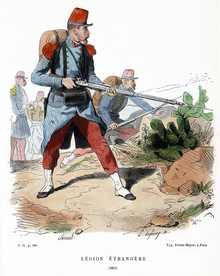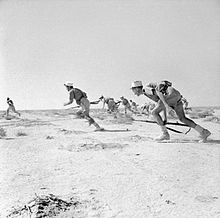History of the French Foreign Legion
The French had a history of employing regiments of foreign soldiers from an early date: such as Louis XI's creation of the Scottish Guards in the 15th century.
Even after the Revolution, the National Assembly in June 1792 created a Foreign Volunteer Legion and in the Revolutionary Wars Dutch, Italian, and Polish soldiers were employed.
[1] On March 9, 1831, the Foreign Legion was created by a royal ordinance issued by King Louis Philippe, at the suggestion of Minister of War Nicolas Jean-de-Dieu Soult.
The formation of the Foreign Legion would help address the domestic threat of dissidents fomenting political instability while contributing to government's colonial endeavors in Algeria.
As part of the Provisional Government's policy of removing potential dissidents from France, upon enlistment recruits were guaranteed anonymity as a condition of their service; information provided to the legion was accepted on face value.
[5] Such enlistments were not within the proposed scope of the Foreign Legion, however the Provisional Government proved not terribly distressed by the voluntary removal of members of a troublesome social element at a time when its control of the nation was less than concrete.
This battalion set about building a barracks and other facilities for the regiment's garrison in addition to draining a nearby marsh and constructing a road in the area.
On April 1, 1832, the Legion's new commander, Colonel Michel Combe, who was himself an ardent advocate of the role of light infantry in the French Army having previously established the Chasseurs à pied.
[13] Col. Bernelle, doubtful of the competence of the Spanish military and their willingness to support the Legion composed of foreigners when their own country was in such disarray, decided to raise additional battalions to supplement his existing forces.
[25] When General Bugeaud assumed command of the Army of Africa and shifted the emphasis of operations in the theater to fast, mobile columns used to pursue the native insurgents through the Algerian countryside, the Foreign Legion responded positively to this new strategy and its overall quality began to improve.
This improvement in quality was in part an effect of these mobile columns allowing the various battalions and companies of the Foreign Legion to be united under a single command as opposed to being dispersed throughout a multitude of defensive blockhouses and garrisons.
[27] The duc d'Aumale was sufficiently impressed by the performance of the Legionaries under his command that he requested that King Louis Philippe grant the regiment its own standard.
[29] For a while the Legion's brigade was held on station at the Gallipoli depot until eight companies were organized into a battalion de marche and assigned to General François Certain Canrobert's division which had also been afflicted by cholera.
[29] The battalion de marche was later disbanded and then reincorporated into their respective parent units in October as the rest of the Legion's forces arrived from Gallipoli.
[31] Following this and a few subsequent actions, the Foreign Legion largely spent its time engaged in engineering duties such as the construction of entrenchments and other defensive works.
[37] It became necessary to quickly move the Legion elements inland to the healthier clime of Córdoba, Veracruz, however this was complicated by Mexican guerrillas harassing their movement.
They fought in North Africa (where they established their headquarters at Sidi-Bel-Abbès in Algeria), Madagascar, and Indochina, where they participated in the celebrated Siege of Tuyên Quang in 1885.
However, in June 1884, hostilities between France and China resumed at Lạng Sơn after a French force attempted to dislodge a Chinese garrison which had not withdrawn from the Tonkin region.
In 1884 two battalions of the Foreign Legion were attached to the 4th Marching Regiment of the 2nd Brigade of the Tonkin Expeditionary Corps during the Bắc Ninh Campaign.
[45] Despite the French government's swift action to accommodate the influx of expatriate volunteers from a legal viewpoint, there still remained the matter of furnishing military training to the new recruits and organizing; Minister of War Adolphe Messimy determined that these men would be formed into provisional units dubbed marching regiments (régiments de marche) to be trained and led by a seasoned officer and NCO cadre drawn from the regiments in North Africa.
[44] It was decreed that the induction of foreign volunteers was to be delayed until twenty days after France had begun to mobilize its forces to avoid impeding the deployment of combat-ready units.
[51] The Foreign Legion was heavily involved in World War II, playing a large role in the Middle East and the North African campaign.
[54] The 11th REI defended the northern Inor Wood near Verdun from the German offensive early on in the battle until June 11, 1940, when the regiment began a fighting retreat to the south.
[54] The 21st Marching Regiment of Foreign Volunteers was deployed to the Maginot Line when the German offensive began, but was shifted to the north of Verdun by the end of May.
[54] In January 1940, French high command made the decision to deploy a brigade to assist Finland in its defense against the forces of the Soviet Union in the Winter War.
A battle in Syria saw two opposing sides fight against each other in a short engagement, and later on the Vichy Legion joined its Free French brethren.
Units of the Legion were involved in the defense of Dien Bien Phu during the First Indochina War and lost a large number of men in the battle.
The Legion force, comprising 27 different nationalities,[57] was attached to the French 6th Light Armoured Division, whose mission was to protect the Coalition's left flank.
The Foreign Legion, unlike other units of the French military which are exclusively male (e.g. submariners), does not prohibit the recruitment of women, but only Susan Travers has ever been selected.
A variable number of women serve in support and administrative positions, but their uniforms do not have the traditional attributes (white cap, red epaulettes and green and blue belt).










